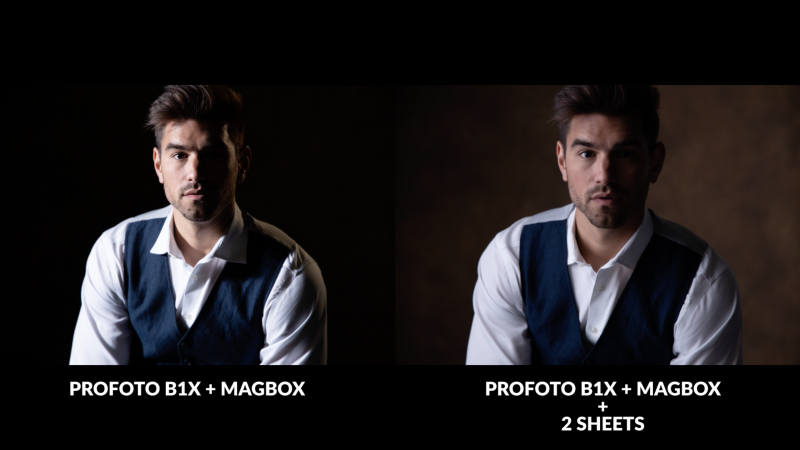
Ever want to re-create natural window light after the sun goes down because you just can’t get enough of it? In this video, we’ll show you just how easy it is to do it, even during the night!
Click to Subscribe!
Sign Up To Learn More About The Lighting 300 Series!
This is an excerpt from our newest Lighting 300 series where we will be diving into advanced lighting techniques like re-creating natural light, golden hour, multi-strobe lighting setups and SO much more! Click the button below to be the first to be notified when the workshops release and to receive special launch discounts!
Sign Up Here!
In this tutorial, we are using a variety of gear, but the most important piece is actually a cheap piece of white fabric. You can get this at any fabric store, just make sure it is pure white with no mix of color.
Step 1: Place Your Light Source In the Right Spot

Window light usually is considered a directional light source since it hits the subject from a stationary point and the photographer then shapes the light by moving the subject. Once you start moving your subject you see that the shadows are either too heavy (split lit) or there aren’t any at all (flat light). Here we are placing the light 90 degrees from the subject to simulate window light. For this shoot, we are using the Profoto B1x at around 8.0 power, which is the equivalent to 1/4th power or approximately 125 Watt/seconds.

This is the result of just the B1x + Magbox + Focus Diffuser. Although this quality of light is passable, it isn’t quite believable that it could be window light due to the specularity of the highlights on the skin.
Step 2: Diffuse Your Light

Light that comes through a window is essentially a large softbox. Since our light is coming through the Magbox with a Focus Diffuser (narrowing the scope of the light to prevent spill on the backdrop) we need to find a way to diffuse it so it simulates window light. We can see that the transition from light to shadow got softer which is a quality found in a natural light source.
Step 3: Adjust The Distance of Your Diffusion In Relation To Your Subject

Moving the diffusion cloth closer to your subject increases the size of the light source. We chose to include a second diffusion cloth to make the light even softer and to really open up the shadows. If you take a look at the comparison between our very first shot without any diffusion and to our final image, you can see the true difference in light quality by inspecting the shadow transition edge:

You can see that we are getting some spill on our backdrop here so to fix that issue, we are going to flag the light source so the light is funneled straight into the cloths. Here are the final images:




Sign Up To Learn More About The Lighting 300 Series!
This is an excerpt from our newest Lighting 300 series where we will be diving into advanced lighting techniques like re-creating natural light, golden hour, multi-strobe lighting setups and SO much more! Click the button below to be the first to be notified when the workshops release and to receive special launch discounts!
Sign Up Here!In this tutorial, we are using a variety of gear, but the most important piece is actually a cheap piece of white fabric. You can get this at any fabric store, just make sure it is pure white with no mix of color.
Step 1: Place Your Light Source In the Right Spot

Window light usually is considered a directional light source since it hits the subject from a stationary point and the photographer then shapes the light by moving the subject. Once you start moving your subject you see that the shadows are either too heavy (split lit) or there aren’t any at all (flat light). Here we are placing the light 90 degrees from the subject to simulate window light. For this shoot, we are using the Profoto B1x at around 8.0 power, which is the equivalent to 1/4th power or approximately 125 Watt/seconds.

This is the result of just the B1x + Magbox + Focus Diffuser. Although this quality of light is passable, it isn’t quite believable that it could be window light due to the specularity of the highlights on the skin.
Step 2: Diffuse Your Light

Light that comes through a window is essentially a large softbox. Since our light is coming through the Magbox with a Focus Diffuser (narrowing the scope of the light to prevent spill on the backdrop) we need to find a way to diffuse it so it simulates window light. We can see that the transition from light to shadow got softer which is a quality found in a natural light source.
Step 3: Adjust The Distance of Your Diffusion In Relation To Your Subject

Moving the diffusion cloth closer to your subject increases the size of the light source. We chose to include a second diffusion cloth to make the light even softer and to really open up the shadows. If you take a look at the comparison between our very first shot without any diffusion and to our final image, you can see the true difference in light quality by inspecting the shadow transition edge:

You can see that we are getting some spill on our backdrop here so to fix that issue, we are going to flag the light source so the light is funneled straight into the cloths. Here are the final images:









Get Connected!